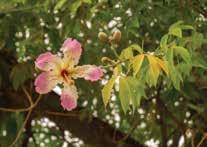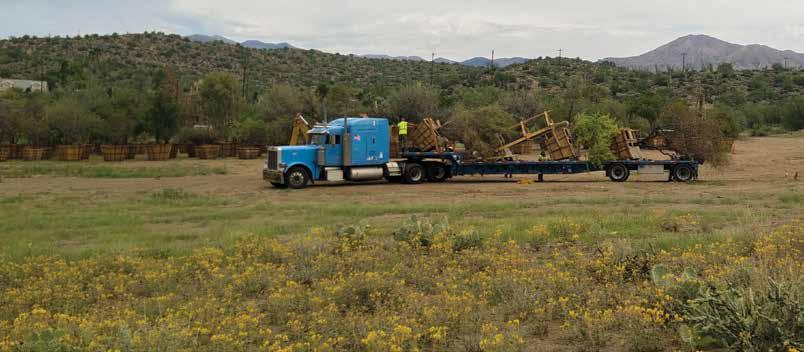
4 minute read
Wallace Desert Garden Update
Text by Jeff Payne, ACLP, Certified Arborist WE - 9449A | Director of Horticulture Artwork by Keegan Rider & Photos by Dara Heward and Joseph Pacheco
Getting Ready for the Wallace Desert Garden Grand Opening
Advertisement
The long-awaited opening of the Wallace Desert Garden will take place in March 2020. The project began in August 2015, when the first boxed specimen cacti arrived at Boyce Thompson from north Scottsdale. Since that time, we moved a total of 5,870 plants, finally finishing the transfer in 2017. Three key employees are now bringing this massive project to completion: myself, lead foreman, Miguel Hernandez, and gardener Derek Lopez. Some of the original players who were very instrumental in getting this project off the ground have either retired or moved on. Cathy Babcock, longtime Director of Horticulture, retired in early 2019. Clayton Newberry, Eddie Valenzuela, and Lisa Galford have new employment elsewhere. New staff members working on the Wallace Garden include our plant recorder, Becky Stephenson, and a new full-time groundskeeper, Angela Velducea, as well as a temporary fulltime groundskeeper, Christine Gomez. We will be adding another full-time groundskeeper very soon.
The final plantings— what we are calling the understory plants— will be in the ground by the time you read this, as will all the plant labels. These understory plants are the smaller plants that BTA staff salvaged from the Wallace Desert Gardens, driving every week on Wednesdays in 2016 and 2017 with two or three trucks and trailers. Every week we would load up the vehicles with bare root specimens or vegetative cuttings for propagation. After doing this for well over a year and a half, we amassed more than 3,300 + plants that we housed in six temporary shade structures at BTA.
It’s quite an involved process, getting these plants in the ground. We first tag a plant in a shade house and then record the inventory control label (contains genus, species, and a specific inventory number). We then create a spreadsheet with the current plant location, I.D. number, genus and species, and its native place of origin. Once this is complete, we take small fluorescent colored marking flags and write the corresponding data from a plant inventory tag on the flag, which shows the plant’s original shade house location, inventory number, genus, and species. We then sort the flags by each plant’s origin and the location where it will be planted in the garden. Wallace Garden staff is given an inventory sheet, and plants are transported from the shade house to the planting location and put into the ground.

Wallace Garden staff also work on weeding, plant care and maintenance, irrigation monitoring, garden trails—and staying cool and hydrated! Weeding is an ongoing and essential task. As some of the plants have been in the ground for two years now, they are becoming established and beginning to grow—so maintenance is a high priority. Irrigation monitoring in such an extensive collection is time-consuming as well. There are a few plants that still need supplemental irrigation to ease them along. Trail construction is almost complete, and by late winter, a final layer of decomposed granite will be placed on the main Wallace loop trail.
At the end of December 2019, we completed plant labels and interpretative signage. December 17 was our plant label day, with BTA Collection Committee members and a number of staff planning an all day placement “blitz” of 700+ signs. Each plant label shows an accepted common name, the most updated botanical name, and the plant’s native origin. Proofing the plant signage has been a lengthy and tedious process, but we wanted to get it right.
Lastly, we are waiting for the final construction dates on the crossings over Queen Creek, part of the Wallace Desert Garden main trail.
The transplanted and transformed Wallace Desert Garden—now on 13 acres with 1.5 miles of trails—offers access to H.B. Wallace’s beautiful collection of desert plants from around the world, as well as spectacular views of the Superstition Mountains. We hope to see every one of you at the Wallace Garden opening in March!

Palo Borracho, Ceiba speciosa hybrid

Palo Borracho, Ceiba speciosa hybrid

Aloe sp. leaf.

Agave victoriae-reginae

Book Leaf Mallee, Eucalyptus Kruseana
In this issue, you will find many pieces of artwork by Keegan Rider, a Tucson based artist who has a love for botanical and cactus gardens. Keegan's recent series is called "Desert Cactus Landscape Series." It might remind one of the diversities found in the desert and how colorful it can be if only one looks. His collection has similar colors and textures that you can find in the upcoming opening of the Wallace Desert Garden. To see more of his work, visit his website at www.keeganrider.com. Keegan mainly finds inspiration for his artwork from the surrounding landscape and environment. Having spent several early childhood years on one of the Indian reservations outside of Tucson, he was greatly influenced by traditional Native American and Mexican figurative art. Following his family’s move to South Tucson, Keegan was also instantly captivated by the local street art and murals. Because of these experiences, he has forged a distinct personal style with bright colors and bold line work. To further diversify his abilities and subject matter, Keegan has vigorously studied several renown Contemporary American illustrators, as well as some of the classic masters of the Impressionist Era. Combining all of these inspirations, his resulting artwork is a balance between beauty and nature, and emphasizes desert flora and landscapes, as well as portraits and illustrations.







